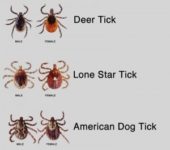
Posted On:
Category: Category:
Alternative EarthCare Shares Tips on Identifying 3 Common Ticks on Long Island’s East End
LONG ISLAND, N.Y., May 29, 2017 Alternative EarthCare has been providing quality residential and commercial services across Long Island, New York since 1996. Specializing in mosquito, flea, and east end tick control service, traditional lawn services (including aeration and seeding), irrigation system services, tree removal and pruning, and Christmas and holiday light installation, the team of professionals successfully caters to your needs in the least toxic, most organic way possible.
East end Long Island residents have become accustomed to overwhelming populations of ticks. Well known for transmitting dangerous diseases such as Lyme Disease, tiny ticks have long plagued residents, though they may be unaware of the types of ticks they are seeing and the other diseases that they may pass to both humans as well as pets. Alternative EarthCare shares tips on identifying three common ticks on Long Island’s east end.
- Black-legged ticks Also known as deer ticks, the black-legged tick is among the most well-known, and most feared ticks on Long Island and throughout the country. This common tick transmits Lyme disease, Rocky Mountain spotted fever, Anaplasmosis, Babesiosis, and the Powassan disease. Deer ticks are one of the smallest ticks, making it difficult to see them sometimes and necessary to conduct thorough body checks after any possible exposure. Black-legged ticks are the size of a pin-head in nymphal form and grow to approximately one-two millimeters long in adult form. Males are dark brown, though they are not the ones to watch out for, the females are. Female deer ticks have a reddish body with dark brown legs, dorsal plate, and mouth parts.
- Lone Star ticks Lone Star ticks, which transmit Ehrlichiosis, STARI, and Tularemia, are fairly easy to identify. Female Lone Start ticks have a white spot on their back and are otherwise characterized by a brownish-red color body that is round, as opposed to most other common ticks which are more oval in shape. Lone Star ticks grow to about four millimeters long and are typically that size when feeding and when spotted. The male of this species has a horseshoe shape spot on their lower back.
- American dog ticks Tularemia, Rocky Mountain spotted fever, and Ehrlichiosis, are all transmitted by the American dog tick. At four to six millimeters long, the American dog tick is among the larger of the tick species. Females are a dark reddish-brown hue with a lighter colored crescent shape plate near the front of their body, while the males have a more unified coloration, though it is spotty across the entire back plate. Though this tick is named the American dog tick, don’t be fooled; they can spread these same diseases to humans.
Serving both Suffolk and Nassau County, including the East End and the Hamptons, Alternative EarthCare offers a variety of organic, non-toxic lawn care services for your home or business. In addition to beautifying and maintaining properties, the award-winning staff is also dedicated to the safety and health of their customers.









